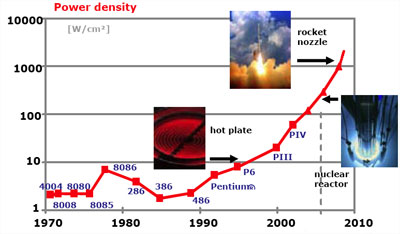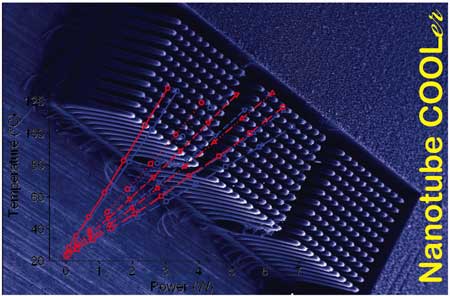| Posted: Apr 12, 2007 | |
Nanotechnology to the rescue of overheating computer chips |
|
| (Nanowerk Spotlight) For computer chips, 'smaller and faster' just isn't good enough anymore. Power and heat have become the biggest issues for chip manufacturers and companies integrating these chips in everyday devices such as cell phones and laptops. The computing power of today's computer chips is provided mostly by operations switching at ever higher frequency. This physically induced power dissipation represents the limiting factor to a further increase of the capability of integrated circuits. Heat dissipation of the latest Intel processors has become a widely discussed issue. By the end of the decade, you might as well be feeling a rocket nozzle than touching a chip. And soon after 2010, computer chips could feel like the bubbly hot surface of the sun itself. As the electronics industry continues to churn out smaller and slimmer portable devices, manufacturers have been challenged to find new ways to combat the persistent problem of thermal management. New research suggests that the integration of carbon nanotubes (CNTs) as heat sinks into electronic devices might provide a solution to this problem. | |
 |
|
| The growing power density (measured in W/cm2) of Intel's microchip processor families. (Source: Intel) | |
| Heat is becoming one of the most critical issues in computer and semiconductor design. There are six fundamental ways the electronics industry faces growing thermal distress: | |
|
|
|
| To reduce high temperatures, today's heat sinks – finned devices made of conductive metal such as aluminum or copper – are attached to the back of the chips to pull thermal energy away from the microprocessor and transfer it into the surrounding air. | |
| Using microfin structures made of aligned multiwalled carbon nanotube arrays mounted to the back of silicon chips, researchers from Rensselaer Polytechnic Institute and the University of Oulu in Finland have proven that nanotubes can dissipate chip heat as effectively as copper – the best known, but most costly, material for thermal management applications. And the nanotubes are more flexible, resilient, and 10 times lighter than any other cooling material available. | |
| "We were able to demonstrate a simple and scalable nanotube-on-chip assembly, using a unique processing and transfer technique to integrate nanotube structures on the chip" Dr. Robert Vajtai explains to Nanowerk. "Once attached to the chip, the advantageous mechanical and thermal properties of carbon nanotubes can be exploited to remove heat from silicon chip components." | |
| Vajtai, the lab manager at Pulickel M. Ajayan's Carbon Nanomaterials Research Group at Rensselaer Polytechnic Institute, is co-author of a recent paper in Applied Physics Letters that describes these novel heat sinks ("Chip cooling with integrated carbon nanotube microfin architectures"). | |
 |
|
| Field emission scanning electron microscopy image of a CNT fin array block. The data points show the difference between the temperature of the chip with (blue) and without (red) the nanotube cooler at differentcooler gas speed. (Image: Dr. Vajtai, RPI) | |
| The trend to increasing miniaturization of electronic devices causes a headache for manufacturers: When reduced to sub-millimeter sizes, the integrity of materials typically used for cooling structures breaks down. Silicon becomes very brittle and easily shatters, while metallic structures become bendable and weak. Carbon nanotubes, however, maintain their impressive combination of high strength, low weight, and excellent conductivity. In addition, the carbon nanotube heat sinks developed by the Finnish-US research team can be manufactured very cost effectively. | |
| The researchers fabricated thick films consisting of approximately 1.2 mm long aligned multi-walled CNTs with diameters between 10 to 90 nm. After detaching the nanotube layers from the templates, structures of 10 x 10 fin array blocks were fabricated in the freestanding films by laser-assisted surface patterning. Each cooling element of CNT fin arrays has a size of ∼ 1.2 x 1.0 x 1.0 mm3 and a mass of only ∼ 0.27 mg. | |
| Compared to a chip with no cooling source, 11 percent more power was dissipated from the chip mounted with the nanotube cooler. Under forced nitrogen flow, the cooling performance with the fins was improved by 19 percent. | |
| "These numbers are consistent with the heat dissipated by the best thermal conductors" says Vajtai. "This demonstrate the possibility of a lightweight, solid-state add-on structure for an on-chip thermal management scheme which works without involving heavy metal block and fan or fluid-flow procedures for heat removal which can greatly increase the weight of electronic devices." | |
| The resulting cooling efficiency of the CNT coolers, in terms of power density, is in the range of microcircuit needs (currently around 100 W/cm2), and they could therefore serve as efficient parts of modern electronic devices. | |
| "Going forward, we would like to carry out investigations on systems which are closer to the real applications both in their size and their geometry" says Vajtai. "We will also try to enhance our method in order to remove a higher percentage of heat and also to explore new paradigms to make the cooler applicable for efficient hot spot removal." | |
| A large number of parameters could be finetuned to improve the CNT coolers' efficiency: Tailoring nanotube structure to obtain higher thermal conductivity, improvement and optimization of the chip-nanotube thermal interface, enlarging the interface surface via using double-sided vertical arrangements, optimizing fin-array geometry spacing, width, and height of fins, heat sink base dimension as well as location, nanotube length, and forest density, and improved gas flow efficiency. | |
| Given the urgency and industrial scale of the problem, there will likely be a tough competition among research groups and labs worldwide racing to build the most effective and efficient CNT coolers. | |
 By
Michael
Berger
– Michael is author of three books by the Royal Society of Chemistry:
Nano-Society: Pushing the Boundaries of Technology,
Nanotechnology: The Future is Tiny, and
Nanoengineering: The Skills and Tools Making Technology Invisible
Copyright ©
Nanowerk LLC
By
Michael
Berger
– Michael is author of three books by the Royal Society of Chemistry:
Nano-Society: Pushing the Boundaries of Technology,
Nanotechnology: The Future is Tiny, and
Nanoengineering: The Skills and Tools Making Technology Invisible
Copyright ©
Nanowerk LLC
|
Become a Spotlight guest author! Join our large and growing group of guest contributors. Have you just published a scientific paper or have other exciting developments to share with the nanotechnology community? Here is how to publish on nanowerk.com.
